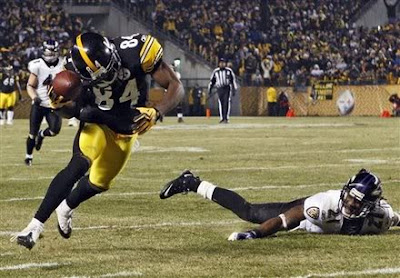The Steelers hit Latrobe this summer looking to avenge their disappointing end to the 2011 campaign. The 2012 season will kick off at the scene of the crime in Denver, and even though there's a different quarterback under center, you'd better believe the black and gold are going to be focused on leaving the Mile High city on a different note this time around.
But between now and September 9th there are a lot of important decisions to be made that will shape the 2012 season. The Steelers hit camp this year with the most roster spots (10, by my count) open for competition of any camp in recent memory. Obviously, the Mike Wallace situation is still hanging over our heads, but we have a good feeling that something will get done soon, since Steps 1 and 2 in the "Re-Sign Mike Wallace"
plan (h/t to
Steelers Lounge) have already taken place.
Here's a look at the depth chart as we enter camp. We'll start with the guys that we consider "locks" to make the 53 man roster for opening day.
Roster Locks (29)
QB: Ben Roethlisberger
RB: Isaac Redman
WR: Mike Wallace, Antonio Brown, Emmanuel Sanders, Jerricho Cotchery
TE: Heath Miller
OT: Marcus Gilbert, Mike Adams
OG: David DeCastro, Willie Colon
C: Maurkice Pouncey
DE: Brett Keisel, Ziggy Hood, Cameron Heyward
NT: Casey Hampton, Steve McLendon
OLB: James Harrison, LaMarr Woodley, Jason Worlids
ILB: Lawrence Timmons, Larry Foote, Shawn Spence
CB: Ike Taylor, Keenan Lewis, Curtis Brown, Cortez Allen
S: Troy Polamalu, Ryan Clark
Note: Rashard Mendenhall will likely begin the season on the Physically Unable to Perform list, which will keep him out the first 6 weeks of the season, but he will not count against the 53-man roster during that time.
Players that should make the team (barring injury, getting arrested, or getting suspended)
(14)
QB: Byron Leftwich, Charlie Batch
RB: Jonathan Dwyer, Chris Rainey
WR: none
TE: Leonard Pope
OT: Max Starks
OG: none
C: Doug Legursky
DE: none
NT: Alameda Ta'amu
OLB: Chris Carter
ILB: Stevenson Sylvester
CB: none
S: Ryan Mundy
Specialists: Shaun Suisham (K), Jeremy Kapinos (P), Greg Warren (LS)
Note: TE Weslye Saunders is suspended for the first 4 games of the season and will not count against the roster during that time. Given his performances last year, I would put him in the "should make the team" category, so it's likely that the Steelers will make a roster move to put him on the 53-man roster after his suspension ends.
So where does that leave us? 29 "Locks" and 14 more that "Should" make the team is 43 players. By my best estimate, there are 10 roster spots open for competition in camp this year.
Battles For Roster Spots
There are 10 roster spots that I see as being "open for competition" and honestly they could be divided any way, but here's an educated guess at how they'll fall.
Running Back: Baron Batch/John Clay
Both of these guys could make the team out of camp. As I said above, Mendenhall won't count against the active roster for 6 weeks and having both of them on the roster would just add to the stable of backs we can throw out on the field. Baron Batch was a training camp superstar last year before tearing his ACL. Batch will likely battle Chris Rainey for the 3rd Down Back job and John Clay could take some of the short-yardage carries from Isaac Redman in the short-term.
Full Back/H-Back: David Johnson/David Paulson/Will Johnson
David Johnson clearly has the inside track to a roster spot here, and it's likely that 7th round pick David Paulson will end up on the practice squad. Will Johnson is an interesting case as he was signed as an undrafted free agent from West Virginia and is the only listed full back on the roster.
Reserve Linemen: Ramon Foster/Trai Essex/Chris Scott/Kelvin Beachum
Chris Scott is likely on his last legs with the Steelers and will need to make a big splash if he is going to earn himself a roster spot. Foster and Essex have been with the team long enough that they have the inside track to the last two roster spots. Foster can play either guard spot (and maybe tackle in a pinch) while Essex can play any of the 5 positions on the line. Beachum, a 7th round pick from SMU, is a likely candidate for the practice squad.
Wide Receiver: Toney Clemons/Derrick Williams/Marquis Maze
The Steelers enter camp with 11 WRs on the roster. It is likely they will only keep 5 on the roster. Toney Clemons was a 7th round pick from Colorado who lit it up in limited appearances for the Buffs. Clemons is a local kid from Valley High School and definitely has the potential to develop into an NFL receiver. Derrick Williams made a name for himself making big plays at Penn State but hasn't had the success in the pros that his college pedigree would suggest. He has a shot to make the team as a kick returner/special teams ace. Marquis Maze had a good career at Alabama and was one of the bigger name undrafted free agents the Steelers picked up after the draft.
Defensive End: Corbin Bryant/Al Woods
It is unlikely that the Steelers will enter the 2012 season with just 3 Defensive Ends on the roster, especially with Casey Hampton likely sitting out the first few games. Bryant and Woods figure to be the next in line to battle it out for a roster spot and should get plenty of playing time in the preseason to sort this one out. We're secretly hoping UDFA Ikponmwosa Igbinosun makes some noise in camp, just so we can use his name more often.
Linebacker: Mortty Ivy/Brandon Hicks/Brandon Johnson
This is purely a spot that can be won on special teams. The top 4 at both OLB and ILB are pretty much set, but a 9th linebacker could play his way onto the team with a solid showing on special teams.
Cornerback: Terrence Frederick/Terry Carter/Andre Freeman
This is another battle that will probably be won on special teams. Frederick was a 7th round pick from Texas A&M and at best will be the #5 corner this year. Carter and Freeman were both UDFAs. The Steelers could still look to bring back a special teams ace like Anthony Madison to fill this role.
Safety: Will Allen/Damon Cromartie-Smith/Myron Rolle
Will Allen is only this far down the list because of his salary cap number being over $1 million. Cromartie-Smith has been with the team for a few seasons and could make for a solid contributor on special teams. With Ryan Clark unable to play in Denver, the Steelers will start the season with at least 4 safeties on the roster, possibly more. Myron Rolle is a great story, having gone to Oxford on a Rhodes Scholarship after graduating from Florida State. Rolle obviously has the intelligence to play safety in LeBeau's scheme, and this should make for a good battle that could come down to special teams play.
Depth Chart Battles
The last 10 roster spots aren't all that will be decided in camp this year. There are also important decisions in the lineup, including starting cornerback opposite Ike Taylor and Left Tackle.
Starting Cornerback: Keenan Lewis/Curtis Brown/Cortez Allen
This should be a fantastic battle that might not get settled in camp. It's possible that we enter the season with two players rotating like B-Mac and Gay did a few years ago. Lewis was the 3rd corner last season but played on the outside as Will Gay moved in to the slot to play the nickel corner position on 3rd downs. Lewis had his best season as a pro last year and playing on the outside on 3rd downs certainly gives him the most experience of the group. Curtis Brown was a special teams all star last year, leading the team in ST tackles. Brown didn't see many snaps on defense last season, but as a 3rd round pick he has the talent to step in and contribute - though his best position might be as the slot/nickel corner. Cortez Allen is an interesting case. A 4th round pick out of The Citadel last year, we weren't really expecting much from Allen as going from FCS to the NFL was a big jump in talent. All Allen did was match up against Rob Gronkowski and lock him up when the Steelers beat the Pats. Allen might be the best man-to-man defender the Steelers have, which could give him a good case to be the #2 corner.
Starting Left Tackle: Mike Adams/Max Starks
During mini camp and OTAs, the Steelers said that Mike Adams would be the starting Left Tackle, but with the re-signing of Max Starks, that could change. The one thing we can take solace in is that we won't have to watch Jonathan Scott be a turnstile between Dwight Freeney and Ben Roethlisberger any more. Adams is the LT of the future, but if he struggles in camp and the preseason, I wouldn't be surprised to see Starks out there on opening day.






























